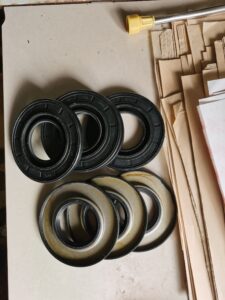Table of Contents
ToggleWhat Is the Difference Between a Seal and an Oil Seal?
The distinction between a seal and an oil seal lies in their applications, materials, designs, and functional roles within mechanical systems. While all oil seals fall under the broader category of seals, they are specifically engineered for unique purposes. Below is a comprehensive breakdown of their differences, structured to clarify their distinct characteristics and uses.


1. Definitions
- Seal:
A general term for any device or material that prevents the passage of fluids (liquids or gases) between two components. Seals are ubiquitous in applications ranging from hydraulic systems and plumbing to aerospace and household appliances. - Oil Seal:
A specialized type of seal designed explicitly to retain lubricants (oil or grease) and exclude contaminants in rotating or reciprocating machinery. Commonly used in engines, gearboxes, pumps, and axles, oil seals ensure lubrication integrity while preventing environmental ingress.
2. Key Functional Differences
The table below highlights the primary distinctions between general seals and oil seals:
| Aspect | Seal | Oil Seal |
| Application | Broad: Hydraulics, pneumatics, water, chemicals, air systems. | Specific: Oil-lubricated systems (e.g., engines, gearboxes, pumps). |
| Material | Varies widely: Silicone (heat resistance), EPDM (water/steam), PTFE (chemical resistance), Viton (high temperature). | Oil-resistant elastomers: Nitrile rubber (NBR), fluorocarbon (FKM), HNBR (high-temperature durability). |
| Design | Diverse forms: O-rings, gaskets, mechanical face seals, labyrinth seals. | Lip seals with dust lips, metal casing, and optional garter springs for shaft contact. |
| Primary Role | Prevent fluid leakage, pressure loss, or contamination. | Retain lubricants, exclude dirt/moisture, and maintain oil integrity. |
| Examples | Hydraulic cylinder seals, faucet gaskets, pipe flange gaskets. | Crankshaft seals, camshaft seals, differential seals, wheel hub seals. |
3. Design and Structural Features
General Seals
- O-rings: Circular elastomeric rings compressed between grooves to block fluid paths.
- Gaskets: Flat seals (e.g., rubber, metal, or composite) used between static flanges.
- Mechanical Face Seals: Two precision-lapped faces (rotating and stationary) pressed together by springs or hydraulic force. Common in pumps and compressors.
- Labyrinth Seals: Non-contact seals creating a tortuous path to impede fluid flow, ideal for high-speed applications.
Oil Seals
- Lip Seal Structure: A primary elastomeric lip maintains contact with the shaft, while a secondary dust lip blocks contaminants.
- Spring-Loaded Design: Many oil seals include a garter spring to ensure consistent lip pressure as the seal wears.
- Metal Case: Provides structural rigidity and enables press-fit installation into housings.
4. Material Considerations
Oil Seals
- Nitrile (NBR): Cost-effective, excellent resistance to petroleum-based oils.
- Fluorocarbon (FKM): Withstands high temperatures (up to 200°C) and aggressive chemicals.
- HNBR: Enhanced thermal and mechanical strength for demanding environments.
General Seals
- Silicone: Heat-resistant and food-grade compliant.
- EPDM: Resistant to water, steam, and weathering.
- PTFE: Chemically inert, suitable for corrosive fluids.
5. Applications in Context
Oil Seals
- Critical in automotive engines to prevent oil leaks, which could lead to overheating or bearing failure.
- Used in gearboxes to retain lubrication and block abrasive particles.
- Found in industrial pumps to separate oil chambers from external environments.
General Seals
- Hydraulic systems: Retain high-pressure fluids in cylinders and valves.
- Plumbing: Prevent water leakage in pipes and faucets.
- Aerospace: Seal cabin pressure and fuel systems.
6. Failure Modes and Maintenance
Oil Seals
- Common Failures:
- Lip wear due to shaft misalignment or abrasive contaminants.
- Degradation from oil additives, extreme temperatures, or chemical exposure.
- Maintenance: Requires periodic replacement; easier to install than mechanical seals.
General Seals
- Common Failures:
- Swelling or cracking from chemical incompatibility.
- Compression set in O-rings due to prolonged stress.
- Maintenance: Mechanical seals may need monitoring for face wear; gaskets often replaced during system overhauls.
7. Industry Standards
- Oil Seals: Governed by ISO 6194 (rotary shaft lip seals) and DIN 3760/3761 standards.
- General Seals: Standards vary by type:
- O-rings: AS568 (size standardization).
- Gaskets: ASTM F104 (non-metallic materials).
- Mechanical Seals: API 682 (refinery applications).
8. Summary of Key Takeaways
- Hierarchy: All oil seals are seals, but not all seals are oil seals.
- Specialization: Oil seals are optimized for lubricant retention and contaminant exclusion in rotating systems.
- Versatility: General seals address diverse needs, from static flange sealing to dynamic fluid containment.
Choosing the Right Seal
- Opt for Oil Seals When:
- Retaining oil/grease and blocking dust is paramount.
- Cost-effectiveness and ease of replacement are priorities.
- Operating conditions (pressure, temperature) align with elastomer capabilities.
- Opt for General Seals When:
- Handling diverse fluids (water, chemicals, gases).
- High-pressure systems or extreme temperatures demand specialized materials.
- Non-rotating applications (e.g., static flanges, hydraulic pistons).



Leave A Comment